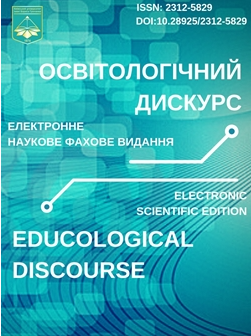SOMATIC MOVEMENTS AS A CONCEPT IN THE MODERN PARADIGM OF PHYSICAL CULTURE AND SPORTS
DOI:
https://doi.org/10.28925/2312-5829.2021.2.3Keywords:
awareness, somatic education, somatic movement, somatic movement education, somatic movement therapyAbstract
As a result of repeated repetition of movements, according to the theory of adaptation, «trace» motor effects «accumulate and contribute to the process of morphological and functional development of the organism and socio-psychological development of the personality of those involved». In the «law of exercise», JB Lamarck said that «frequent and prolonged use of the body gradually strengthens it, and vice versa». However, the development of physical and mental abilities is not limited to the effects of movement on the human body. There is another side of the «law of exercises», which was first formulated by D. Diderot, and scientifically substantiated by M.O. Bernstein (1947) in the «theory of coordination» - «the body itself, using exercises, builds its own movements». Preliminary analysis of scientific sources showed the fragmentary study of this «other side», which determined this study’s relevance.
The concept of «somatic movements» requires perception, understanding, and comprehension. Taken as a basis for the study of the problem of consciousness, «Phenomenology of Spirit» «belongs to those works without which it is impossible to imagine either the history of philosophy or philosophy as such». Hegel’s goal is «to trace and demonstrate the path that consciousness takes, from direct sensory perception to scientific (philosophical) knowledge, which reveals the rationality of reality».
An essential element of the presented study is the study of the Western classification of somatic movements. The International Somatic Movement Education and Therapy Association (ISMETA) defines somatic education as «The professional field of somatic movement education and therapy spans holistic education and complementary and alternative medicine. The field contains distinct disciplines, each with its own educational and/or therapeutic emphases, principles, methods, and techniques». (Eddie M., 2009, p. 8).
It is extremely important to understand this concept, which depends on the awareness of the «operational concept» of the object of somatic education.
The ability to aware is an integral part of somatic education and an essential component of its effectiveness. The study of the concept of «awareness» is based on the Feldenkrais method, based on «somatic movements».
Downloads
References
Iсторiя фiлософiї: підручник / В. І. Ярошовець, О. В. Алєксандрова, Г. Є. Аляєв та ін. Київ. 927 с.
Круцевич Т. Ю. Теорія і методика фізичного виховання : підручник. Київ : Олімпійська література, 2012. 392 с.
Dragon D. A. Creating cultures of teaching and learning: Conveying dance and somatic education pedagogy. Journal of Dance Education. 2015, 15(1), 25-32, DOI:10.1080/15290824.2014.995015
Eddy M. A brief history of somatic practices and dance: Historical development of the field of somatic education and its relationship to dance. Journal of Dance & Somatic Practices. 2009, 1(1), 5-27, DOI:10.1386/jdsp.1.1.5_1 (https://doi.org/10.1386/jdsp.1.1.5_1).
Feldenkrais M. Embodied wisdom: The collected papers of Moshe Feldenkrais. Berkeley, California : North Atlantic Books, 2011. 229 с.
Lundqvist L. O., Zetterlund C., & Richter H. O. Effects of Feldenkrais method on chronic neck/scapular pain in people with visual impairment: a randomized controlled trial with one-year follow-up. Archives of Physical Medicine and Rehabilitation. 2014, 95(9), 1656-1661, DOI:10.1016/j.apmr.2014.05.013 (https://doi.org/10.1016/j.apmr.2014.05.013).
Mullan K. J. Somatics: Investigating the common ground of western body–mind disciplines. Body, Movement and Dance in Psychotherapy. 2014, 9 (4), 253-265, DOI:10.1080/17432979.2014.946092
Rywerant Y. Acquiring the Feldenkrais profession. Tel Aviv, Israel : El-Or Ltd, 2000. 63 с.
Saumaa H. Somatic Practices: Going Beyond the Classroom to Build Resilience and Gain New Insights. Alternative and Complementary Therapies. 2020, 26(3), 106-108, DOI:10.1089/act.2020.29276.hsa
Teixeira-Machado L., Araújo F. M., Cunha F. A., Menezes M., Menezes T., & DeSantana J. M. Feldenkrais method-based exercise improves quality of life in individuals with Parkinson's disease: a controlled, randomized clinical trial. Alternative therapies in health and medicine. 2015, 21(1), 8-14, PMID: 25599428.
Dragon, D. A. (2015). Creating cultures of teaching and learning: Conveying dance and somatic education pedagogy. Journal of Dance Education, 15(1), 25-32, DOI:10.1080/15290824.2014.995015 https://doi.org/10.1080/15290824.2014.995015 (eng).
Eddy, M. (2009). A brief history of somatic practices and dance: Historical development of the field of somatic education and its relationship to dance. Journal of Dance & Somatic Practices, 1(1), 5-27, DOI:10.1386/jdsp.1.1.5_1 (eng).
Feldenkrais, M. (2011). Embodied wisdom: The collected papers of Moshe Feldenkrais. Berkeley, California: North Atlantic Books (eng).
Istorija filosofiji: pidruchnyk (2010). V. I. Jaroshovecj, O. V. Aljeksandrova, Gh. Je. Aljajev (Ed.). K.: VPC «Kyjivsjkyj universytet», 927 (ukr).
Lundqvist, L. O., Zetterlund, C., & Richter, H. O. (2014). Effects of Feldenkrais method on chronic neck/scapular pain in people with visual impairment: a randomized controlled trial with one-year follow-up. Archives of Physical Medicine and Rehabilitation, 95(9), 1656-1661, DOI:10.1016/j.apmr.2014.05.013 (eng).
Mullan, K. J. (2014). Somatics: Investigating the common ground of western body–mind disciplines. Body, Movement and Dance in Psychotherapy, 9(4), 253-265, DOI:10.1080/17432979.2014.946092 (eng).
Rywerant, Y. (2000). Acquiring the Feldenkrais profession. Tel Aviv, Israel: El-Or Ltd (eng).
Saumaa, H. (2020). Somatic Practices: Going Beyond the Classroom to Build Resilience and Gain New Insights. Alternative and Complementary Therapies, 26(3), 106-108, DOI:10.1089/act.2020.29276.hsa (eng).
Teixeira-Machado, L., Araújo F. M., Cunha, F. A., Menezes, M., Menezes, T., & DeSantana, J. M. (2015). Feldenkrais method-based exercise improves quality of life in individuals with Parkinson's disease: a controlled, randomized clinical trial. Alternative therapies in health and medicine, 21(1), 8-14, PMID: 25599428 (eng).
Teorija i metodyka fizychnogho vykhovannja : pidruchnyk (2012). T. Ju. Krucevych. K.: VP «Olimpijsjka literatura», 392 (ukr).
Published
How to Cite
Issue
Section
License
Copyright (c) 2021 Educological discourse

This work is licensed under a Creative Commons Attribution-NonCommercial 4.0 International License.
Автори зберігають за собою всі авторські права та одночасно надають журналу право першої публікації на умовах лізенції Creative Commons Attribution-NonCommercial-ShareAlike 3.0 Unported License, що дозволяє розповсюджувати даний матеріал із зазначенням авторства та первинної публікації в даному журналі.





















